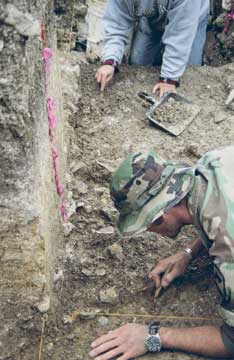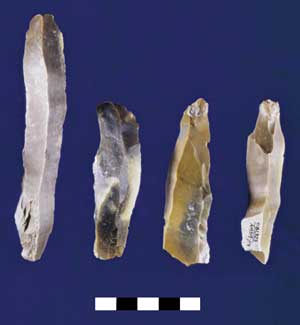|
NEWS NOTES — NEWS
Geoarchaeology
“Clovis first” in doubt
 |
| A student at Texas A&M University found blades (below) made by the Clovis people at this site in Texas. The Clovis people were once thought to be the first Americans, but new radiocarbon dating is suggesting otherwise. Photograph above is by Michael Waters. Photograph below is by Charlotte Pevny. |
 |
The Clovis culture, characterized by its bone and ivory fluted spear points, has long held the attention of archaeologists, many of whom believe the technology represents evidence of the first people to inhabit the Americas. But Clovis’ status as the first Americans has now been called into question by new radiocarbon dates that indicate Clovis technology flourished for a much shorter time than previously thought.
For “the last 50 years, our ideas about the first Americans have been dominated by the ‘Clovis first’ model,” says Michael Waters, a geoarchaeologist at Texas A&M University and co-author of the study published Feb. 23 in Science. This model claims that Clovis people migrated throughout North and South America as the first humans on either continent. In the past four decades, 22 archaeological sites throughout the Americas have been considered examples of Clovis culture. Radiocarbon-dated materials from these locations indicated that the culture lingered from 11,500 to 10,900 radiocarbon years before present.
Waters, however, was not convinced of the accuracy of these dates. He teamed with Thomas Stafford, an expert in radiocarbon dating with Stafford Research Laboratories in Colorado, to identify only the sites that were undisputed “Clovis.” This purification step allowed them to rule out half of the sites for lack of precise dates or artifacts that defined them as Clovis. On the remaining 11 sites, they used a new, extremely precise mass spectrometer that enables the dating of tiny bits of material. Not only does the new technique ensure the dated material is not contaminated, but it provides ages to within 30 years.
The sites now date from roughly 11,050 to 10,800 radiocarbon years before present — a stretch of just 250 years. Waters says the smaller time range makes it difficult to accept that the Clovis group alone pushed from the northern parts of North America to the tip of South America. “It’s simply not enough time to adapt to various environments, learn animal behaviors, learn what plants they could and could not eat, and get through the disease corridor of Central America,” he says. Instead, Waters and Stafford suggest that other human groups existed pre-Clovis, possibly arriving on the South American continent by boat. They also note that this shorter and later time range for Clovis dates the culture’s existence precisely to the downfall of megafauna, such as mammoths, further linking human presence to mass extinctions.
Yet not everyone is ready to break with the traditional “Clovis first” hypothesis. Anthropologist Gary Haynes of the University of Nevada at Reno says that Waters and Stafford ruled out half of the Clovis sites based on “shaky reasoning.” Just because culturally significant artifacts haven’t been found at a site, he notes, doesn’t mean they aren’t there. “It may just be that they are Clovis sites that nobody’s found a fluted arrow from yet,” he says. Haynes admits, however, that the paper “is going to get people talking, start people rethinking the dating” of the old Clovis sites.
But even if Clovis had been around for, say 400 years instead of 200, as some older dates indicate, that still might not have been enough time to migrate such a long distance, says archaeologist Tom Dillehay of Vanderbilt University. After all, “people did not come into the new world with a road map pointing the way south.”

 Subscribe
Subscribe


